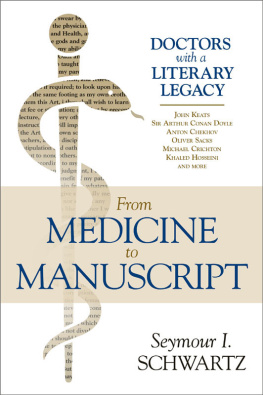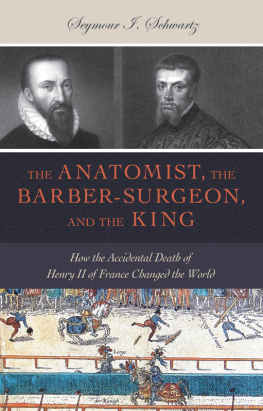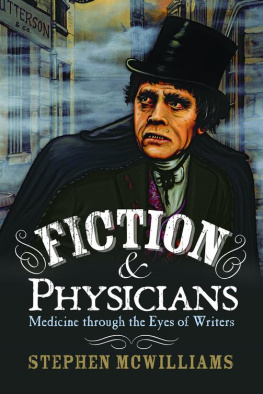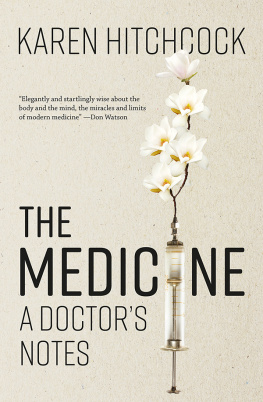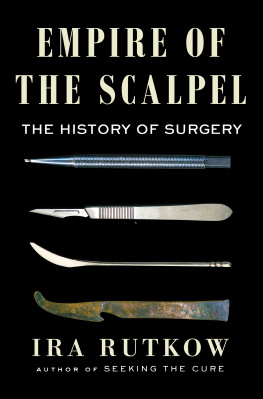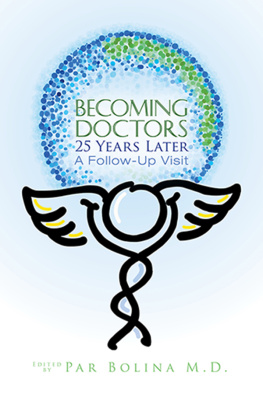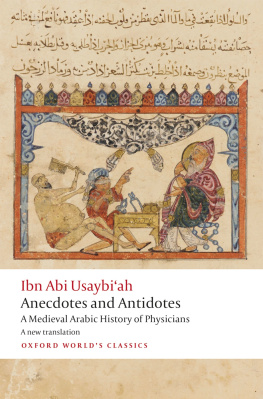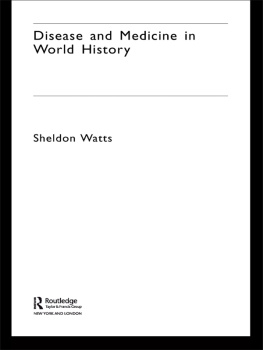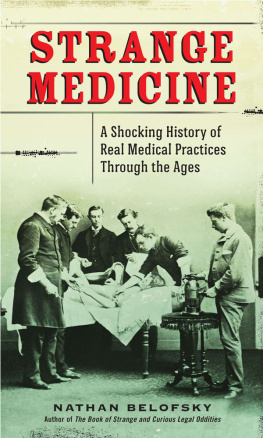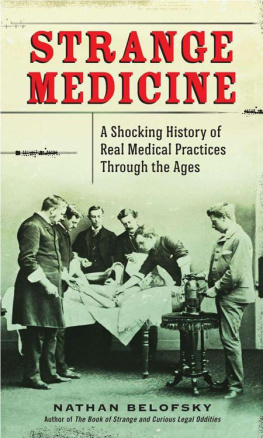
Three individuals have provided invaluable service and support over the past decade, during which I have researched, written, and published three volumes of nonfiction. Steven L. Mitchell, in his role as editor in chief of Prometheus Books, has shepherded Cadwallader Colden: A Biography (2013), The Anatomist, the Barber-Surgeon, and the King: How the Accidental Death of Henry II of France Changed the World (2015), and this current consideration of sixty-five physicians, who have left a literary legacy, through the process of publication. Gianna Nixon-Saldinger has overseen the selection and visually optimized the illustrative material in all three books. In addition, her organizational skills have been much appreciated. Dr. Marshall Lichtman, an eminent hematologist, medical school dean, and scholar, provided a critical review of every inclusion. Marshall's shared commitment to the importance of the humanities in the education of physicians was a continuing encouragement.

The genesis of a series of essays concerning the lives of individuals who have combined medical experience with literary notability was a personal quest for an explanation. I had recently delivered a quasi-autobiographical talk entitled Scribo Ergo Sum, implying an absolute necessity to write. I asked myself, Does such a compulsion exist?
During my youth, I had little interest in literature or composition, and throughout my early education, as well as my undergraduate and medical schooling, that lack of interest persisted. As an aspiring academic surgeon, I had published basic scientific research articles and clinical considerations in peer-reviewed journals. At the same time, I had developed a concentrated interest in liver surgery, a recently evolving field. I avidly read the literature of past accomplishments related to liver surgery, and became aware that there was no inclusive work on the subject.
Reinforced by the dictum proposed by Francis Bacon in the seventeenth century that reading maketh a full man, conference a ready man, and writing an exact man, I presumptuously compiled the first textbook in English on the subject, Surgical Diseases of the Liver (1964). The publisher of that book, shortly thereafter, embarked on the production of a new textbook of surgery and selected me to head the editorial board. Principles of Surgery appeared in 1969, and I subsequently shepherded the textbook through seven editions. During that period, I also edited The Yearbook of Surgery and a monthly journal, Contemporary Surgery, each issue of which called for me to compose a historical, philosophical, or otherwise titillating essay. Representative essays were compiled and published as Surgical Reflections (1993).
On the occasion of my achieving tenure as an academic surgeon at my university, my wife pointed out that I was monolithic and suggested that I needed a hobby. I asked that she find one for me, and, the next day, she handed me a secondhand book on the history of cartography, indicating that the subject might capture my interest. I became a collector of early maps pertaining to America and embarked on scholarship regarding the subject. Once again, I concluded that a vacuum existed in that there was no definitive book on the subject. This led to The Mapping of America (1979), coauthored with Ralph Ehrenberg. My continued interest in cartography led to the publications of The French and Indian War (1995), An Englishman's Journey along America's Eastern Waterways (2000), This Land Is Your Land (2000), The Mis-Mapping of America (2003), and Putting America on the Map (2007).
In 2005, my career as an operating surgeon came to an end. This, coupled with the completion of an eleven-year period of serving as chair of surgery and surgeon in chief of my university's hospital, allowed for more leisure time. The void was filled with an increased dedication to scholarship, writing, and more diversification. Several books of more panoramic scope resulted. Gifted Hands: America's Most Significant Contributions to Surgery (2009), Holystic Medicine: The Patron Saints of Medicine (2011), Cadwallader Colden: A Biography (2013), and The Anatomist, the Barber-Surgeon, and the King (2015) were published.
Having come to the conclusion that I have harbored a compulsion to write, one that has intensified with time, I sought an answer to the question why? I reached out to more significant and notable kindred souls who have combined medicine with literary productivity. Perhaps a study of their lives would help to determine if there is a pattern or an explanation.
The journey has been long and arduous, but, also, informative and entertaining. I have made many new acquaintances and accumulated many new heroes. I soon realized that each of the individuals whose life and writings I investigated was unique. The investigation, which extended from the distant past to more modern times and into the present, has uncovered a broad spectrum of individuals. Some bear names that are well known; some names are eponymous, and some have faded into obscurity. Diversity dominates, while the question that served as the stimulus for this project remains unanswered.


The period in European history that extended from 500 to 1500 CE has been referred to as the Middle Ages or medieval period. Positioned between the rich Greco-Roman classical period and the Renaissance, which refers to the rebirth of the past artistic and intellectual advancements, the Middle Ages were characterized by stagnation and retrogression. Consequently, the bracketed thousand years is often referred to as the Dark Ages.
The early Middle Ages (5001000 CE) were preceded by the disruption of the Roman Empire, followed by the mass migration of ethnic groups into the lands that had been occupied by the Roman Empire, and the rise and rapid growth of Islam. In the late Middle Ages (13001500 CE), although education continued to be focused on the training of the clergy, the development of universities spread throughout Europe. During the late Middle Ages, Dante Alighieri (d. 1321), Giovanni Boccaccio (d. 1375), Geoffrey Chaucer (d. 1400), and Franois Villon (d. 1463) contributed to the rise of vernacular literature.
In the so-called high Middle Ages (10001300 CE), science was stagnant, and those interested in intellectual inquiry were entrapped in atmospheric doldrums. During the high Middle Ages, one individual who produced notable literary works and gained an unrivaled reputation as a physician flourished. That man, whose literary contributions to the interpretation of Jewish law earned him the acronymic name of the Rambam (Rabbi Moses ben Maimon), is considered the most notable postbiblical Jewish personality. At the same time, he served as personal physician to the sultan of Egypt and provided medical care for countless followers of Islam. He was deemed to be equivalent to the most highly regarded of the medieval Arab physicians.
Moses ben Maimon, best known by his Hellenized name, Maimonides, was born in Cordoba, Spain, on March 30, 1138. At the time, Cordoba was part of an Islamic empire that permitted non-Muslims to live in harmony. Maimonides's father, Maimon, a judge of the rabbinical court of Cordoba, was a member of a distinguished family, which, for seven generations, produced leaders of the Jewish community in Spain. Young Maimonides was educated, mainly, by his father. His education included the Jewish laws and history, astronomy, mathematics, philosophy, and rhetoric.
Next page
